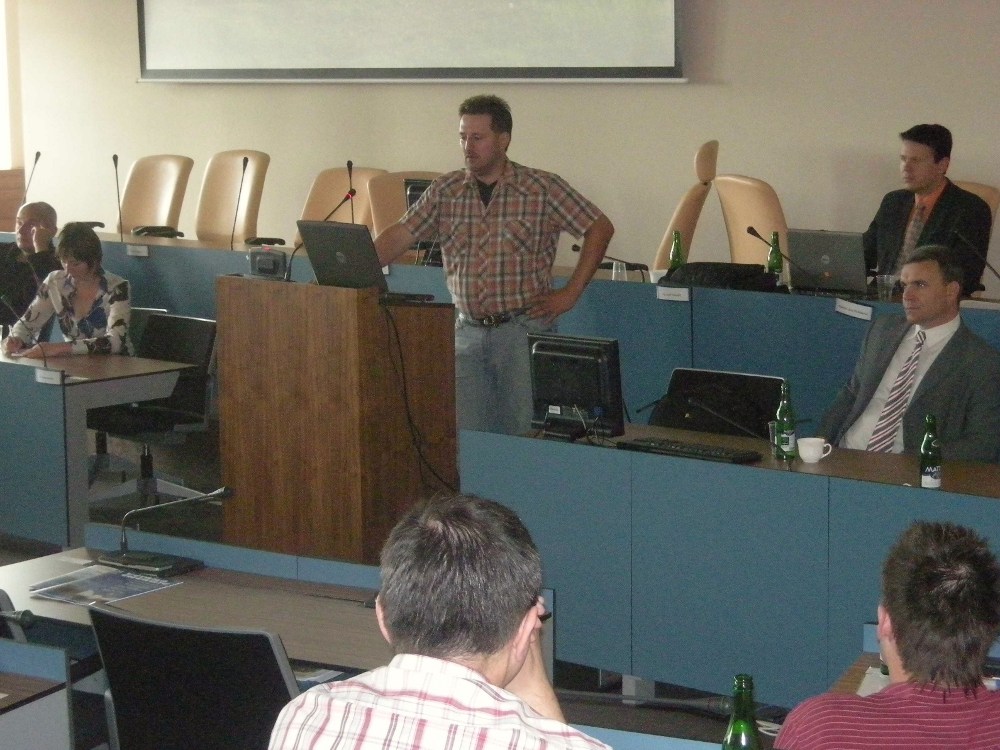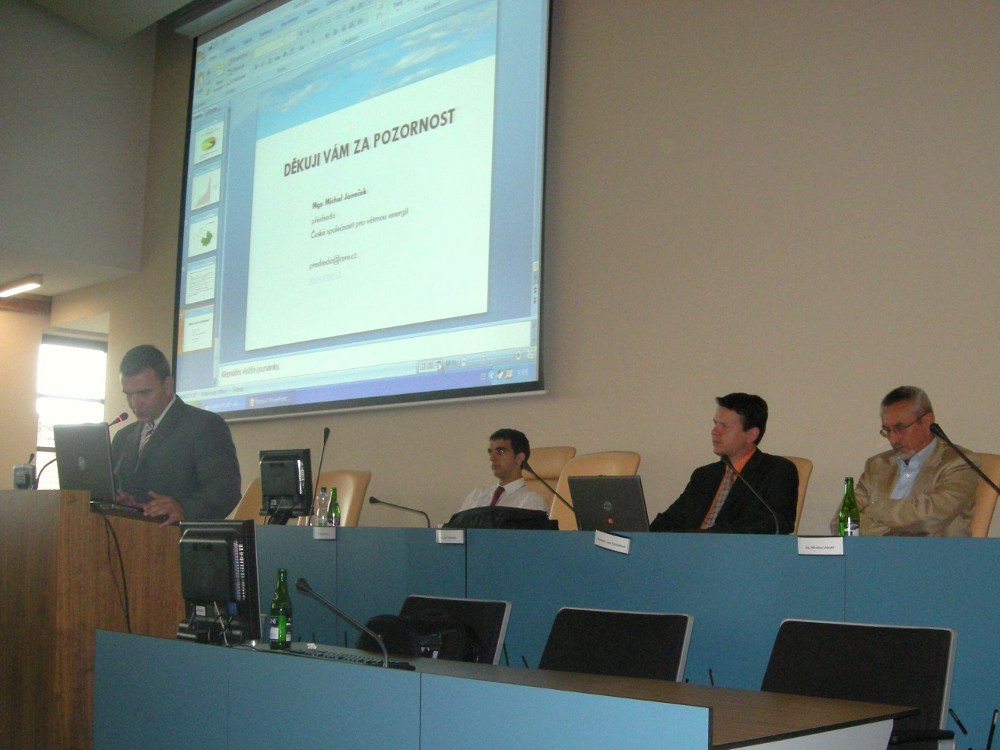Wind Energy Conference in the Hradec Králové Region
The Conference on the wind energy aspects in the Czech Republic and its further development possibilities took place in the prestigious rooms in the office building of the Hradec Králové Region on June 11. People from the municipalities in the Hradec Králové Region and people from areas touched by the construction and operation of wind farms were invited to participate in the conference.
The conference was opened after 9 o'clock with a short speech by Mgr. Michal Janeček, the chairman of the Wind Energy Association (hereinafter as ČSVE), who immediately gave the floor to Ing. Jan Tippner who is a member of the Council of the Hradec Králové Region with the competence for environment and agriculture. He briefly explained his positive attitude towards wind turbines. He also presented an interesting comparison of the impact of wind energy production on the character of landscape. The landscape character in the North Bohemia is severely disturbed by mining for coal power plants comparing to a simple turbine standing freely in the countryside affecting the character of landscape only slightly. In the end he made a wish that the conference would be a source of inspiration for wind energy projects in the Hradec Králové Region.
After Mr. Janeček returned to the speaker’s desk to inform about the current situation of wind energy in the Czech Republic. The information about the success rate of intents in the EIA documentation from the total number of submitted proposals in the Czech Rep. was highly interesting. In 2004 there were 8 successful projects out of 11, in 2007 only 6 out of 28 submitted and in 2008 there was not even one successful from the total of 46! It is a rather alarming piece of information if we consider that no regulation or law was amended during the time. A related paper was given by Ing. Pavel Prchal from CSVE informing about the wind energy potential in the Hradec Králové Region.

Bc. Kučera presented results from a unique survey done by the Czech Academy of Science. The study, he participated in, was dedicated to the survey of the attitudes of Czech people in areas affected by the construction of wind farms. In a standard questionnaire survey he addressed 551 respondents in the area of Pavlov, Protivanov, Drahany and Odry. The best idea would be to show all charts and results of the study as they were full of new information which has not been published in the Czech Republic yet. Briefly speaking, the period before the construction of wind turbines is accompanied by the fear from the unknown invoking a rather negative attitude. Only 43% of respondents have positive comments. However when the construction is finished and several months' operation accomplished most people admit wind turbines have no negative impact on the surrounding by noise or disturbances of landscape character. The percentage of supporters raises over 60%. The number of consistent opponents is constant between 11 and 12%. The respondents also said the tourism was not disturbed, the number of tourists in the particular location slightly increased. In the end the dependence of attitudes on the source of information on wind turbines was presented. The result showed that the biggest opponents of wind turbines gather the information from friends and neighbors or from the press. People with positive attitudes recruit from those who gather information from web or from companies working in the field.
Before a break Ing. Marek took the floor and spoke about wind turbines and the specifics of winter operation. He briefly described technical options of ice detection on wind turbines and possible solutions of the situation. There was an interesting piece of information based on the examination of a wind turbine in the area with frequent frost (near Pavlon in Vysočina Region) – the operation was interrupted due to ice for only 3 days in the year. He also described a standard defrosting system. Under the supervision of workers preventing the danger of injury in the nearby area the rotor is slowly turned and the ice breaks when the blades are deflected and falls due to its dead load.
3 papers given by people who assume the impact of wind turbines on the environment in practice followed after the break. Firstly, Ing. Jiráska from the National Reference Laboratory spoke, dealing with the measurement and assessment of noise made by wind turbines. In his presentation he showed several results of noise measurements at a wind turbine in the field and then he commented the frequently mentioned issue of infrasound at wind turbines. His comment was brief and pregnant: “Wind turbines make no infrasound. It is an exaggerated topic in the Czech Republic with no real justification and once for all I would like to close it as groundless. Wind turbines make some "noise" as any other machine, however the frequency and intensity of sound is in completely different spectrum than infrasound and it is not a current problem for wind turbines to maintain the noise level of 40dB specified by standard.”
Mgr. Kočvara from Palacký University Olomouc continued. On a long term basis he deals with the observations of birds and bats near wind turbines. He warned against taking over the result of foreign studies as every area has its own specifics in the life of birds and bats. Generally, the higher wind turbine the smaller impact and potential risk for birds as the rotor is located higher. It is confirmed also by observations from Czech locations. The tower of the wind turbine near Drahany is 105m high and there is a big bat population nearby. During the whole observation period there was no bat death recorded. Only the death of 2 birds was recorded, namely of a kind with strong population in the Czech Republic. From a lot of other interesting information one could be quoted. In Germany wind turbines killed 24 White-tailed Eagles in 2006 however cars on roads killed 120 eagles in the same period.

Dr. Obst was the last one of the three dealing with the issue of wind turbines from the viewpoint of landscape character. One of the first fact showed that if a construction is labeled with a significant landscape impact, the community perceive the information as negative, which is a rather misleading and groundless generalization. He briefly described the map compilation methods (using fractal geometry) dealing with the visibility and intensity of wind turbine visual impact in the landscape.
Mgr. Hájek and Ing. Langarová gave the last paper dealing with the relation of wind turbines and sightseeing value. If the European Landscape Convention was applied (used in the rest of Europe) and correctly implemented in the decisive process, it could significantly help to locate wind turbines in this country. Ing. Langarová mentioned wind turbines as positive aesthetic landscape experience which may create a dominant point or visual stimulus to which we subconsciously keep returning.

Mgr. Janeček took the floor for final words after 2 p. m. closing the conference. During the whole conference many questions and comments came from the audience provoking immediate discussion. The conference hopefully served the purpose and gave its participants much relevant information helpful for wind energy projects.




